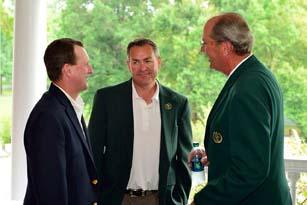 It's not uncommon for a superintendent to admit that golfer demands can make their job more challenging. For golfers themselves to concede such a thing is another matter entirely, but that's the case at Saucon Valley Country Club, where members demand much from Jim Roney, and they know it.
It's not uncommon for a superintendent to admit that golfer demands can make their job more challenging. For golfers themselves to concede such a thing is another matter entirely, but that's the case at Saucon Valley Country Club, where members demand much from Jim Roney, and they know it.
When Saucon Valley green chairman Robin McCool sought support for Roney for the 2014 TurfNet Superintendent of the Year Award, presented by Syngenta, he called upon a host of Roney's colleagues, including USGA Green Section agronomist Darin Bevard. It would have been easy for McCool to bury or even discard what Bevard had written. Instead, he put it at the top of the list, almost like a badge of honor.
"Saucon Valley is a very unique club, and correspondingly, Jim has a very unique and demanding job," Bevard wrote. "It has been said that there may not be a more challenging job in the industry."
Roney, 43, oversees conditions on not one, not two, but three 18-hole courses and a six-hole layout at Saucon Valley, all of which must be at their best on a daily basis. The property encompasses 850 total acres and straddles two counties (and thus two different municipal governments). It also is a regular stopping point for USGA championships and qualifiers. And while members toss credit to Roney for his ball-juggling skills and agronomic expertise in producing top-flight conditions on three-plus layouts, he deflects praise to an engaged crew from which he demands much, such as volunteering at several professional tournaments each year, some as far away as California.
 For his ability to maximize playability over such a vast area and under such demanding conditions, Roney was named a finalist for this year's Superintendent of the Year Award.
For his ability to maximize playability over such a vast area and under such demanding conditions, Roney was named a finalist for this year's Superintendent of the Year Award."The easiest way to describe it is we have three championship-caliber courses, and there are high expectations for each," Roney said. "We are constantly recruiting people: talent, interns, assistants. I call them nucleus employees. I try to assistants that they are superintendents-in-training. Everybody brings an intangible, and we try to empower people and give them rope. Accountability dictates how long the rope is."
Saucon Valley members recognize their property is special and that it can and should play a key role in supporting the golf industry locally, regionally and nationally. The site of many USGA qualifiers, the club was home to the 2009 U.S. Women's Open and the 2014 U.S. Amateur.
"Saucon Valley members always want to give back," said Roney, who has been at the property since 2005. "For the Women's Open, we had 65 volunteers (signed up) five months out. The Mid-Am is different. The Mid-Am doesn't get a lot of praise, and it was hard to get help. We needed 140 bodies for the tournament, and we pulled it off with 80. On top of that, another golf course here was still open for play."
Keeping everything open for play can be a challenge, especially during rain events as the property is located in a watershed, and several acres are prone to severe flooding.
According to McCool, as many as 23 holes were under water on several occasions during three separate tournaments in 2014. Roney has developed a flood-mitigation plan that typically has event the most severely affected holes open and ready for play in less than two days.
After he won the 2014 U.S. Mid-Am at Saucon Valley, golfer Scott Harvey said the greens were like putting on "pool tables."
"His understanding of championship preparation as well as the importance of meeting member expectations on a daily basis is unsurpassed in my experience," Bevard said.
With all the day-to-day challenges a property like Saucon Valley can present, Roney sees staff development among his greatest contributions to the industry. Former assistant Chad Mark of The Kirtland Country Club in Willoughby, Ohio, is, for another month anyway, the reigning TurfNet Superintendent of the Year.
He sends six to eight people from his crew each year to volunteer and hone their tournament-prep skills at events like the U.S. Open, the Memorial Tournament in Dublin, Ohio, and the PGA Tour's Northern Trust Open at Riviera Country Club near Los Angeles.
His philosophy often places assistants on the fast track for jobs elsewhere. And that means he spends a lot of time hiring and training. And that's OK.
"I don't have the luxury of keeping good people," Roney said. "I have a wonderful staff. And when you're recognized for having good guys, they're going to get opportunities."
Roney is one of 10 finalists for the award. Finalists are chosen by a panel of judges from a field of nominees based on the following criteria: labor management, maximizing budget limitations, educating and advancing the careers of colleagues and assistants, negotiating with government agencies, preparing for tournaments under unusual circumstances, service to golf clientele, upgrading or renovating the course and dealing with extreme or emergency conditions.
The winner will be named Feb. 26 at the Golf Industry Show in San Antonio. Previous winners include: Chad Mark (2013); Dan Meersman (2012); Paul Carter, CGCS (2011); Thomas Bastis, CGCS (2010); Anthony Williams, CGCS (2009); Sam MacKenzie (2008); John Zimmers (2007); Scott Ramsay, CGCS (2006); Mark Burchfield (2005); Stuart Leventhal, CGCS (2004); Paul Voykin (2003); Jeff Burgess (2002); Kip Tyler (2001); and Kent McCutcheon (2000).

